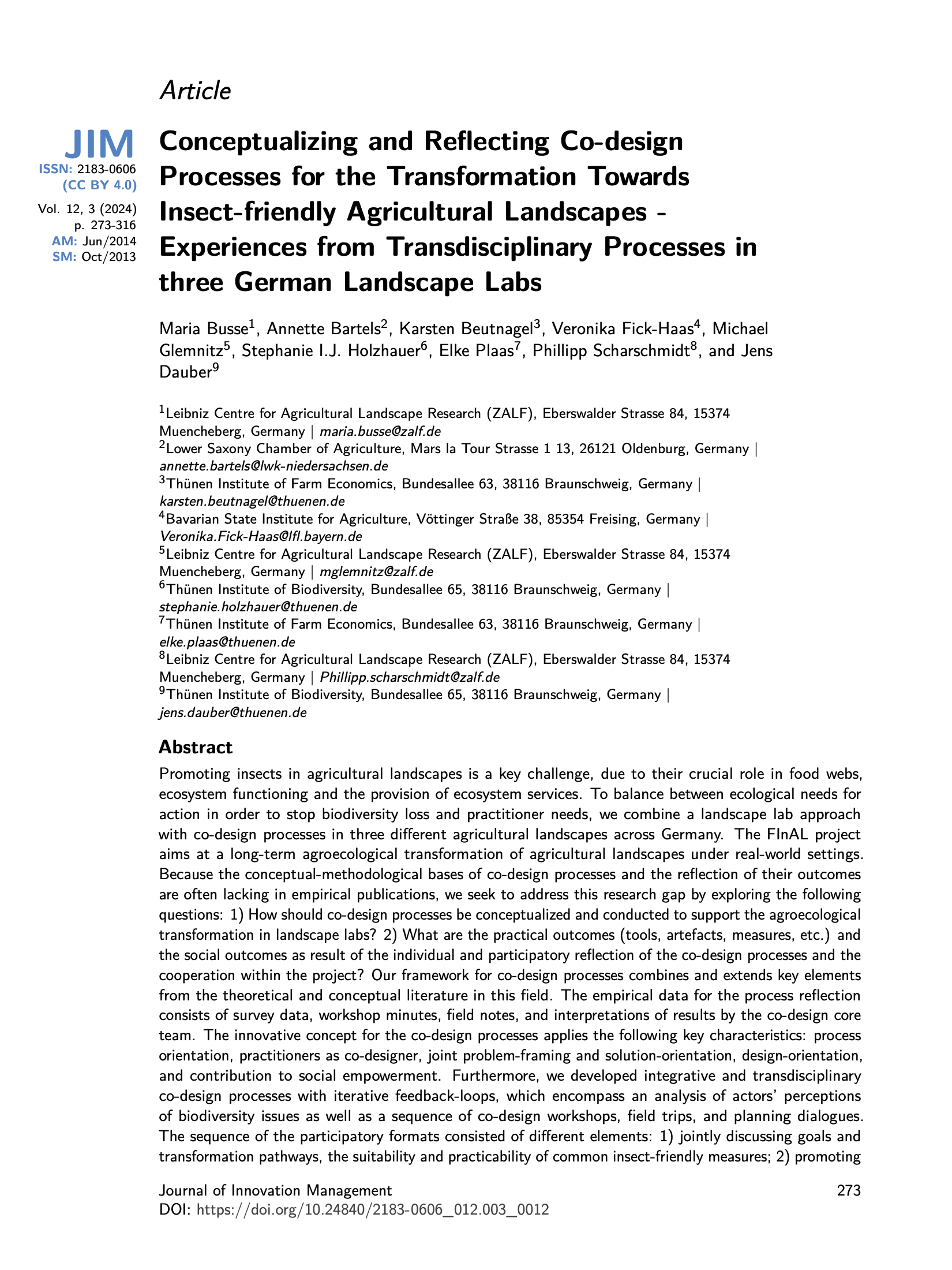Conceptualizing and Reflecting Co-design Processes for the Transformation Towards Insect-friendly Agricultural Landscapes - Experiences from Transdisciplinary Processes in three German Landscape Labs [Special Issue on Living Labs and Collaborative Innovation]
Main Article Content
Abstract
Promoting insects in agricultural landscapes is a key challenge, due to their crucial role in food webs, ecosystem functioning and the provision of ecosystem services. To balance between ecological needs for action in order to stop biodiversity loss and practitioner needs, we combine a landscape lab approach with co-design processes in three different agricultural landscapes across Germany. The FInAL project aims at a long-term agroecological transformation of agricultural landscapes under real-world settings. Because the conceptual-methodological bases of co-design processes and the reflection of their outcomes are often lacking in empirical publications, we seek to address this research gap by exploring the following questions: 1) How should co-design processes be conceptualized and conducted to support the agroecological transformation in landscape labs? 2) What are the practical outcomes (tools, artefacts, measures, etc.) and the social outcomes as result of the individual and participatory reflection of the co-design processes and the cooperation within the project? Our framework for co-design processes combines and extends key elements from the theoretical and conceptual literature in this field. The empirical data for the process reflection consists of survey data, workshop minutes, field notes, and interpretations of results by the co-design core team. The innovative concept for the co-design processes applies the following key characteristics: process orientation, practitioners as co-designer, joint problem-framing and solution-orientation, design-orientation, and contribution to social empowerment. Furthermore, we developed integrative and transdisciplinary co-design processes with iterative feedback-loops, which encompass an analysis of actors’ perceptions of biodiversity issues as well as a sequence of co-design workshops, field trips, and planning dialogues. The sequence of the participatory formats consisted of different elements: 1) jointly discussing goals and transformation pathways, the suitability and practicability of common insect-friendly measures; 2) promoting farmers’ ideas and co-designing measures; 3) participatory mapping of planned measures at the landscape scale; and 4) reflecting the implemented measures and the transdisciplinary process itself. The first results of the participatory reflection include: participating farmers state that they are generally satisfied with the adaptable co-design process but they perceive that collaboration at landscape level has barely increased. For strengthening collaboration and empowering actors it is crucial to 1) build upon established science-practice networks; 2) involve landscape coordinators as regional intermediaries and permanent contact persons for all activities in the landscapes; 3) promote active and continuous involvement and co-experimentation at the landscape level that leads to mutual trust and co-learning; and 4) provide financial compensation as an incentive.
Article Details
Authors who publish with this journal agree to the following terms:
- Authors retain copyright and grant the journal right of first publication with the work simultaneously licensed under a Creative Commons Attribution License that allows others to share the work with an acknowledgement of the work's authorship and initial publication in this journal.
- Authors are able to enter into separate, additional contractual arrangements for the non-exclusive distribution of the journal's published version of the work (e.g., post it to an institutional repository or publish it in a book), with an acknowledgement of its initial publication in this journal.
- Authors are permitted and encouraged to post their work online (e.g., in institutional repositories or on their website) prior to and during the submission process, as it can lead to productive exchanges, as well as earlier and greater citation of published work (See The Effect of Open Access).

